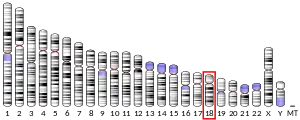| PIEZO2 | |||||||||||||||||||||||||||||||||||||||||||||||||||
|---|---|---|---|---|---|---|---|---|---|---|---|---|---|---|---|---|---|---|---|---|---|---|---|---|---|---|---|---|---|---|---|---|---|---|---|---|---|---|---|---|---|---|---|---|---|---|---|---|---|---|---|
 | |||||||||||||||||||||||||||||||||||||||||||||||||||
| |||||||||||||||||||||||||||||||||||||||||||||||||||
| Identifiers | |||||||||||||||||||||||||||||||||||||||||||||||||||
| Aliases | PIEZO2, C18orf30, C18orf58, DA3, DA5, FAM38B, FAM38B2, HsT748, HsT771, MWKS, piezo type mechanosensitive ion channel component 2, DAIPT | ||||||||||||||||||||||||||||||||||||||||||||||||||
| External IDs | OMIM: 613629 MGI: 1918781 HomoloGene: 49695 GeneCards: PIEZO2 | ||||||||||||||||||||||||||||||||||||||||||||||||||
| |||||||||||||||||||||||||||||||||||||||||||||||||||
| |||||||||||||||||||||||||||||||||||||||||||||||||||
| |||||||||||||||||||||||||||||||||||||||||||||||||||
| |||||||||||||||||||||||||||||||||||||||||||||||||||
| Wikidata | |||||||||||||||||||||||||||||||||||||||||||||||||||
| |||||||||||||||||||||||||||||||||||||||||||||||||||
Piezo-type mechanosensitive ion channel component 2 is a protein that in humans is encoded by the PIEZO2 gene.[5] It has a homotrimeric structure, with three blades curving into a nano-dome, with a diameter of 28 nanometers.[6]
Function
Piezos are large transmembrane proteins conserved among various species, all having between 24 and 36 predicted transmembrane domains. 'Piezo' comes from the Greek 'piesi,' meaning 'pressure.' The PIEZO2 protein has a role in rapidly adapting mechanically activated (MA) currents in somatosensory neurons.[7] Its structure is resolved via a mouse version in 2019, showing the predicted homotrimeric propeller.[8]
PIEZO2 is typically found in cell types that respond to physical touch, such as Merkel cells,[9] and is thought to regulate light touch response.[10]
Pathology
- Gain-of-function mutations in the mechanically activated ion channel PIEZO2 cause a subtype of Distal Arthrogryposis.[11]
- Mice without PIEZO2 in their proprioceptive neurons show uncoordinated body movements, indicating that PIEZO2 plays a role in mammalian proprioception.[12]
- PIEZO2 mutations link Gordon syndrome (distal arthrogryposis type 3), Marden-Walker syndrome and Arthrogryposis (Distal Arthrogryposis Type 5).[13]
See also
References
- 1 2 3 GRCh38: Ensembl release 89: ENSG00000154864 - Ensembl, May 2017
- 1 2 3 GRCm38: Ensembl release 89: ENSMUSG00000041482 - Ensembl, May 2017
- ↑ "Human PubMed Reference:". National Center for Biotechnology Information, U.S. National Library of Medicine.
- ↑ "Mouse PubMed Reference:". National Center for Biotechnology Information, U.S. National Library of Medicine.
- ↑ "Entrez Gene: Piezo-type mechanosensitive ion channel component 2". Retrieved 2013-08-06.
- ↑ Wang L, Zhou H, Zhang M, Liu W, Deng T, Zhao Q, et al. (September 2019). "Structure and mechanogating of the mammalian tactile channel PIEZO2". Nature. 573 (7773): 225–229. Bibcode:2019Natur.573..225W. doi:10.1038/s41586-019-1505-8. PMID 31435011. S2CID 201116189.
- ↑ Coste B, Mathur J, Schmidt M, Earley TJ, Ranade S, Petrus MJ, et al. (October 2010). "Piezo1 and Piezo2 are essential components of distinct mechanically activated cation channels". Science. 330 (6000): 55–60. Bibcode:2010Sci...330...55C. doi:10.1126/science.1193270. PMC 3062430. PMID 20813920.
- ↑ Wang L, Zhou H, Zhang M, Liu W, Deng T, Zhao Q, et al. (September 2019). "Structure and mechanogating of the mammalian tactile channel PIEZO2". Nature. 573 (7773): 225–229. Bibcode:2019Natur.573..225W. doi:10.1038/s41586-019-1505-8. PMID 31435011. S2CID 201116189.
- ↑ Wu J, Lewis AH, Grandl J (January 2017). "Touch, Tension, and Transduction - The Function and Regulation of Piezo Ion Channels". Trends in Biochemical Sciences. 42 (1): 57–71. doi:10.1016/j.tibs.2016.09.004. PMC 5407468. PMID 27743844.
- ↑ Faucherre A, Nargeot J, Mangoni ME, Jopling C (October 2013). "piezo2b regulates vertebrate light touch response". The Journal of Neuroscience. 33 (43): 17089–94. doi:10.1523/jneurosci.0522-13.2013. PMC 6618434. PMID 24155313.
- ↑ Coste B, Houge G, Murray MF, Stitziel N, Bandell M, Giovanni MA, et al. (March 2013). "Gain-of-function mutations in the mechanically activated ion channel PIEZO2 cause a subtype of Distal Arthrogryposis". Proceedings of the National Academy of Sciences of the United States of America. 110 (12): 4667–72. Bibcode:2013PNAS..110.4667C. doi:10.1073/pnas.1221400110. PMC 3607045. PMID 23487782.
- ↑ Woo SH, Lukacs V, de Nooij JC, Zaytseva D, Criddle CR, Francisco A, et al. (December 2015). "Piezo2 is the principal mechanotransduction channel for proprioception". Nature Neuroscience. 18 (12): 1756–62. doi:10.1038/nn.4162. PMC 4661126. PMID 26551544.
- ↑ McMillin MJ, Beck AE, Chong JX, Shively KM, Buckingham KJ, Gildersleeve HI, et al. (May 2014). "Mutations in PIEZO2 cause Gordon syndrome, Marden-Walker syndrome, and distal arthrogryposis type 5". American Journal of Human Genetics. 94 (5): 734–44. doi:10.1016/j.ajhg.2014.03.015. PMC 4067551. PMID 24726473.
Further reading
- Uher R, Tansey KE, Henigsberg N, Wolfgang M, Mors O, Hauser J, et al. (GENDEP Investigators; MARS Investigators; STAR*D Investigators) (February 2013). "Common genetic variation and antidepressant efficacy in major depressive disorder: a meta-analysis of three genome-wide pharmacogenetic studies". The American Journal of Psychiatry. 170 (2): 207–17. doi:10.1176/appi.ajp.2012.12020237. PMC 10416089. PMID 23377640.
- Ahn MJ, Won HH, Lee J, Lee ST, Sun JM, Park YH, et al. (March 2012). "The 18p11.22 locus is associated with never smoker non-small cell lung cancer susceptibility in Korean populations". Human Genetics. 131 (3): 365–72. doi:10.1007/s00439-011-1080-z. PMID 21866343. S2CID 16395362.
- Del-Aguila JL, Beitelshees AL, Cooper-Dehoff RM, Chapman AB, Gums JG, Bailey K, et al. (February 2014). "Genome-wide association analyses suggest NELL1 influences adverse metabolic response to HCTZ in African Americans". The Pharmacogenomics Journal. 14 (1): 35–40. doi:10.1038/tpj.2013.3. PMC 3812324. PMID 23400010.
- Coste B, Houge G, Murray MF, Stitziel N, Bandell M, Giovanni MA, et al. (March 2013). "Gain-of-function mutations in the mechanically activated ion channel PIEZO2 cause a subtype of Distal Arthrogryposis". Proceedings of the National Academy of Sciences of the United States of America. 110 (12): 4667–72. Bibcode:2013PNAS..110.4667C. doi:10.1073/pnas.1221400110. PMC 3607045. PMID 23487782.
- Wang X, Shaffer JR, Zeng Z, Begum F, Vieira AR, Noel J, et al. (December 2012). "Genome-wide association scan of dental caries in the permanent dentition". BMC Oral Health. 12: 57. doi:10.1186/1472-6831-12-57. PMC 3574042. PMID 23259602.
- Xiao R, Xu XZ (November 2010). "Mechanosensitive channels: in touch with Piezo". Current Biology. 20 (21): R936-8. doi:10.1016/j.cub.2010.09.053. PMC 3018681. PMID 21056836.
- Coste B (January 2011). "[Feeling the pressure? Identification of two proteins activated by mechanical forces]". Médecine/Sciences. 27 (1): 17–9. doi:10.1051/medsci/201127117. PMID 21299953.
- Dubin AE, Schmidt M, Mathur J, Petrus MJ, Xiao B, Coste B, Patapoutian A (September 2012). "Inflammatory signals enhance piezo2-mediated mechanosensitive currents". Cell Reports. 2 (3): 511–7. doi:10.1016/j.celrep.2012.07.014. PMC 3462303. PMID 22921401.
- Luykx JJ, Bakker SC, Lentjes E, Neeleman M, Strengman E, Mentink L, et al. (February 2014). "Genome-wide association study of monoamine metabolite levels in human cerebrospinal fluid". Molecular Psychiatry. 19 (2): 228–34. doi:10.1038/mp.2012.183. PMID 23319000. S2CID 8713026.
This article incorporates text from the United States National Library of Medicine, which is in the public domain.



